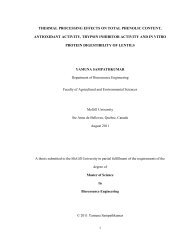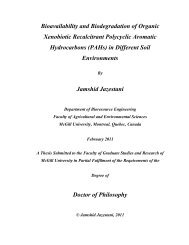Postharvest treatments to reduce chilling injury symptoms in stored ...
Postharvest treatments to reduce chilling injury symptoms in stored ...
Postharvest treatments to reduce chilling injury symptoms in stored ...
Create successful ePaper yourself
Turn your PDF publications into a flip-book with our unique Google optimized e-Paper software.
1.1 Introduction:<br />
I. GENERAL INTRODUCTION<br />
Accord<strong>in</strong>g <strong>to</strong> FAO, United Nation report 2002, the world agricultural growth has<br />
slowed down from an average 2.2 per cent annually over the past 30 years <strong>to</strong> 1.5 per cent<br />
year until 2030. On the other hand, the world population growth will be grow<strong>in</strong>g at an<br />
average of 1.1 per cent a year up <strong>to</strong> 2030, compared <strong>to</strong> 1.7 per cent annually over the past<br />
30 years. This will put an <strong>in</strong>creased pressure on the land <strong>to</strong> produce more food <strong>to</strong> fulfill<br />
the requirement of the grow<strong>in</strong>g population all over the world. Fruit and vegetable<br />
production is lower than gra<strong>in</strong> production, however, they contribute important nutrients <strong>to</strong><br />
the diet, <strong>in</strong>clud<strong>in</strong>g vitam<strong>in</strong>s A and C, folic acid, potassium, and dietary fiber (Mukherjee,<br />
1997). In 1970, vegetables were considered as one of the lead<strong>in</strong>g sources for vitam<strong>in</strong> C<br />
and were contribut<strong>in</strong>g 50 % of the supply, while fruits contributed 39 %. By 1994, fruits<br />
contribution of vitam<strong>in</strong> C <strong>in</strong>creased contribut<strong>in</strong>g 44 % of the <strong>in</strong>ternational supply. Fruits<br />
contribute 12 % of the folic acid, a nutrient that is known <strong>to</strong> <strong>reduce</strong> the risk of heart<br />
disease and cancer. They also contribute 12 % of potassium, a m<strong>in</strong>eral with beneficial<br />
effects on blood pressure (Putnam and Allshouse, 1997). Consumers tend <strong>to</strong> prefer fresh<br />
fruits and vegetables rather than processed or canned food and postharvest losses of fresh<br />
fruits and vegetables are one of the major problem of the food <strong>in</strong>dustry (Borrud et al.,<br />
1996). Surveys have revealed that a substantial portion of the harvest is wasted annually<br />
due <strong>to</strong> improper harvest<strong>in</strong>g and postharvest practices, disease and lack of facilities and<br />
technology <strong>to</strong> extend s<strong>to</strong>rage life. <strong>Postharvest</strong> losses have been estimated <strong>in</strong> developed<br />
countries <strong>to</strong> range from 5-25 % while <strong>in</strong> develop<strong>in</strong>g countries it is 20-50 %, depend<strong>in</strong>g<br />
upon the commodity (Kader, 1992). This cont<strong>in</strong>ues <strong>to</strong> cause heavy losses <strong>in</strong> revenue for<br />
the grower, wholesaler, retailers and exporters.<br />
Prior <strong>to</strong> consumption it is extremely important for local and export markets <strong>to</strong><br />
<strong>reduce</strong> the losses and reta<strong>in</strong> high quality and freshness of harvested products.<br />
Furthermore, the export of fruits <strong>to</strong> distant markets needs special technology that ensures<br />
that the consumer receives a high quality product and value for their money. Mangoes<br />
(Mangifera <strong>in</strong>dica L.) are considered as one of the choice subtropical fruit crops of the<br />
world due <strong>to</strong> their attractive color, delicious taste and nutritive value. The problem, which<br />
1









